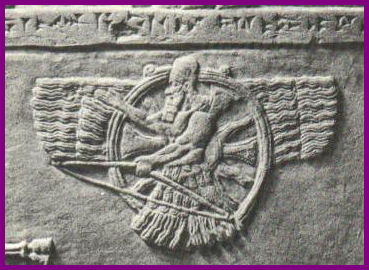Struggling Over the Imago Dei (Part I)
 priestly material of the Torah. The best representatives of Holiness Theology are Ezekiel and the HS strand of the Torah.
priestly material of the Torah. The best representatives of Holiness Theology are Ezekiel and the HS strand of the Torah.My paper presents several sample issues where these two theologies part company, and one of these examples is the nature of the Imago Dei, the Image of God.
I thought I would do some blog posts sharing what I am learning about the Imago Dei, and its different intepretations in Bible. Let's start with Holiness Theology, where the Imago seems visual and, indeed, rather anthropomorphic!
Ezekiel's visions of God really push the envelope in giving us visual images of the divine. The prophet goes so far as to describe the occupant of the throne atop God’s chariot carriage. He claims that God’s presence on the throne has a “likeness” or “semblance” (דמות), which he attempts to articulate. Peering up and into the heart of God’s glory, Ezekiel tells us, he sees what looks like a throne, and “upon this semblance of a throne, there was the semblance of a human form” (Ezek 1:26 NJPS emphasis added). Something very similar occurs at Ezek 8:2 (LXX), where God appears with “a likeness [דמות] as the appearance of a man” (NASB). The Image of God for Ezekiel has a flaming lower body and a humanoid head and upper torso, much like the god Ashur in Mesopotamian iconography.

Reverence Theology would be aghast at what Ezekiel is attempting. Using the self-same Hebrew word (דמות), Isa 40–66 insists that God’s semblance is fully incomparable. Isaiah 40:18 inquires rhetorically, “To whom then will you liken God, or what likeness compare with him?” No answer is possible; God cannot be compared to anything at all. The Holy One, at Isa 40:25, asks a similar question, “To whom then will you compare [דמה] me?” And again at 46:5 God asks, “To whom can you compare [דמה] me or declare me similar? To whom can you liken me, so that we seem comparable?” (NJPS). There is no way around it. Reverence Theology insists repeatedly that you must never claim “God is like this” or “God is like that.”
Yet, Reverence Theology also has a notion of an Imago Dei, and I'll save that for the next post in this series...
4 Comments:
Steve,
So what do you make of the Imago Dei? What is it and why or how are we made in it? Is it the idea that we can make tools and are cognizant? Is it that we have a soul/spirit which makes us a "living being?" Is it that we can offer worship to God in a conscience moment of self reflection?
Looking forward to this post and series of posts.
Thanks so much, Joe! Yes, I'll be arguing that different streams of tradition in Bible make different theological points about the Imago. I believe that for HS and Ezekiel, one main point is that God has made us in such a way that human and divine can be present to each other, that humans can recognize, imagine, and inter-relate with God's presence and power. ---SLC
On a bit of a side note, Hector Avalos traces the use sensory imagery in connection to revelation in a forthcoming Semeia essay. He argues that the DtrH prefers hearing over seeing in its rhetoric of revelation; whereas Job prefer seeing over hearing. Off the top of my head, I wonder about the sensory imagery in Isa 40-66 and Ezekiel. Its interesting that in Isa 40, one also gets the repeated "have you not heard?" rhetoric in relation those statements that the author affirms regarding divine revelation (cf. "Listen to me" in Isa 46:3, 12 etc.). On the other hand, "listening" in Ezekiel is often connected to refusals or breakdowns in divine/human communication; whereas the visual plays a large role in the rhetoric of revelation. Although this goes beyond the imago dei, I'm wondering if the different methods of theological rhetoric that you examine in Isa, Ezek, and various Priestly strands could be put into conversation with other parts of the canon?
JDS
Thanks. The whole question of which senses the prophets and other biblical writers emphasize is just fascinating to me. Avalos' argument that the Deuteronomists prefer to emphasize verbal revelation sounds right on target to me. Bob Wilson has made a similar argument in _Prophecy and Society_. Ezekiel, for his part, is one of the most richly sensory prophets I have studied. Reading his prophecies, you feel the ground shake, the wind blow, the blaze of fire on your skin, etc., etc. ---S.
Post a Comment
<< Home